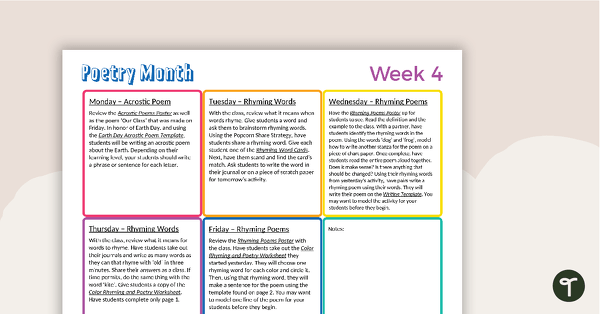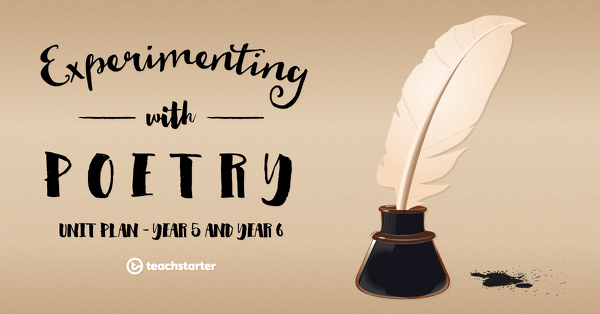Literary Devices Teaching Resources
Bring literary devices to life this school year with printable worksheets and games, poetry analysis resources, figurative language interactives and so much more!
This teaching resource collection includes curriculum-aligned activities and worksheets designed to help your students learn to use similes and metaphors, bring hyperbole and personification into their writing and explore more literary devices in poetry. Editable resources are available to easily differentiate instruction for individual learners and your state standards.
Has it been a while since you taught ELA, or at least this particular part of the curriculum? We know a quarter of American teachers switch grades every year, and sometimes you could use a quick refresher. Read on for a primer from our teacher team!
What Is a Literary Device? A Kid-Friendly Definition
When we're teaching our students how to analyze different texts, teaching them about literary devices can help them make sense of what the author is trying to say. But what is a literary device?
A literary device is a tool a writer uses to make the text more interesting or engaging for the reader. Authors use these tools to create deeper meaning and add layers of complexity to their writing, whether it's in fiction, poetry or even non-fiction.
6 Literary Device Examples to Share With Students
If we wanted to create a full literary device list, you'd find at least 30 different items on there — everything from juxtaposition to repetition qualifies as a literary device. But when we're talking about the literary devices that are typically introduced in elementary or middle school, the list gets shorter. Here are some examples of the devices most common in this stage:
1. Similes
A simile is a comparison between two things using "like" or "as." For example, if a student writes "I was as quiet as a mouse," that's a simile.
2. Metaphors
A metaphor is similar to a simile (and the two are often confused), but this device compares two things without using "like" or "as." The comparison is more implicit. For example, "The class was a zoo when the teacher was absent" uses metaphor.
3. Personification
Personification is giving human qualities or characteristics to a non-human object. For example, an author might say "The trees waved at me as I went by."
4. Hyperbole
Hyperbole is an exaggeration writers use for emphasis or effect. A good example is "It took forever to drive to Grandma's house."
5. Onomatopoeia
Onomatopoeia is a word that imitates a sound and is popular in comic books and other types of writing. Words like bam and clack are good examples of this device!
6. Alliteration
Alliteration is the repetition of the same sound at the beginning of words in a sentence. The popular tongue twister "Sally sells seashells by the seashore" is an example of alliteration.
- Plus Plan

Primary Weekly Poetry Guide - Weeks 4 and 5
Use this weekly poetry guide to celebrate National Poetry Month in your primary classroom.
- Plus Plan

Primary Weekly Poetry Guide - Week 3
Use this weekly poetry guide to celebrate National Poetry Month in your primary classroom.
- Plus Plan

Primary Weekly Poetry Guide - Week 2
Use this weekly poetry guide to celebrate National Poetry Month in your primary classroom.
- Plus Plan

Primary Weekly Poetry Guide - Week 1
Use this weekly poetry guide to celebrate National Poetry Month in your primary classroom.
- Plus Plan

Celebrating Poetry Month in the Primary Grades – Weeks 4 and 5
Celebrate National Poetry Month in the primary classroom with this planning guide and set of resources.
- Plus Plan

Celebrating Poetry Month in the Primary Grades - Week 3
Celebrate National Poetry Month in the primary classroom with this planning guide and set of resources.
- Plus Plan

Celebrating Poetry Month in the Primary Grades - Week 2
Celebrate National Poetry Month in the primary classroom with this planning guide and set of resources.
- Plus Plan

Celebrating Poetry Month in the Primary Grades - Week 1
Celebrate National Poetry Month in the primary classroom with this planning guide and set of resources.
- Plus Plan

Exploring Poetry - Year 3 and Year 4 Unit Plan
This English unit addresses common poetic devices such as sound play, word play and imagery and explores how these may be applied to narrative poetry.
- Plus Plan

Idioms
A 60 minute lesson in which students will explore some commonly used idioms.
- Plus Plan

Figurative Language
A 60 minute lesson in which students will identify and investigate figurative language in poetry.
- Plus Plan

Word Play in Poetry
A 60 minute lesson in which students will identify and explore word play in poetry.
- Plus Plan

Sound Play in Poetry - Alliteration
A 60 minute lesson in which students will identify and explore alliteration in poetry.
- Plus Plan

Exploring Poetic Devices
A 60 minute lesson in which students will explore the common literary devices found in poetry.
-

Teachers' Favorite Fall Poems for Kids to Add to Your Classroom Poetry List
Bring autumn into the classroom with fall poems for kids from classic authors plus teacher-created activities to teach personification, onomatopoeia, and more elements of poetry.